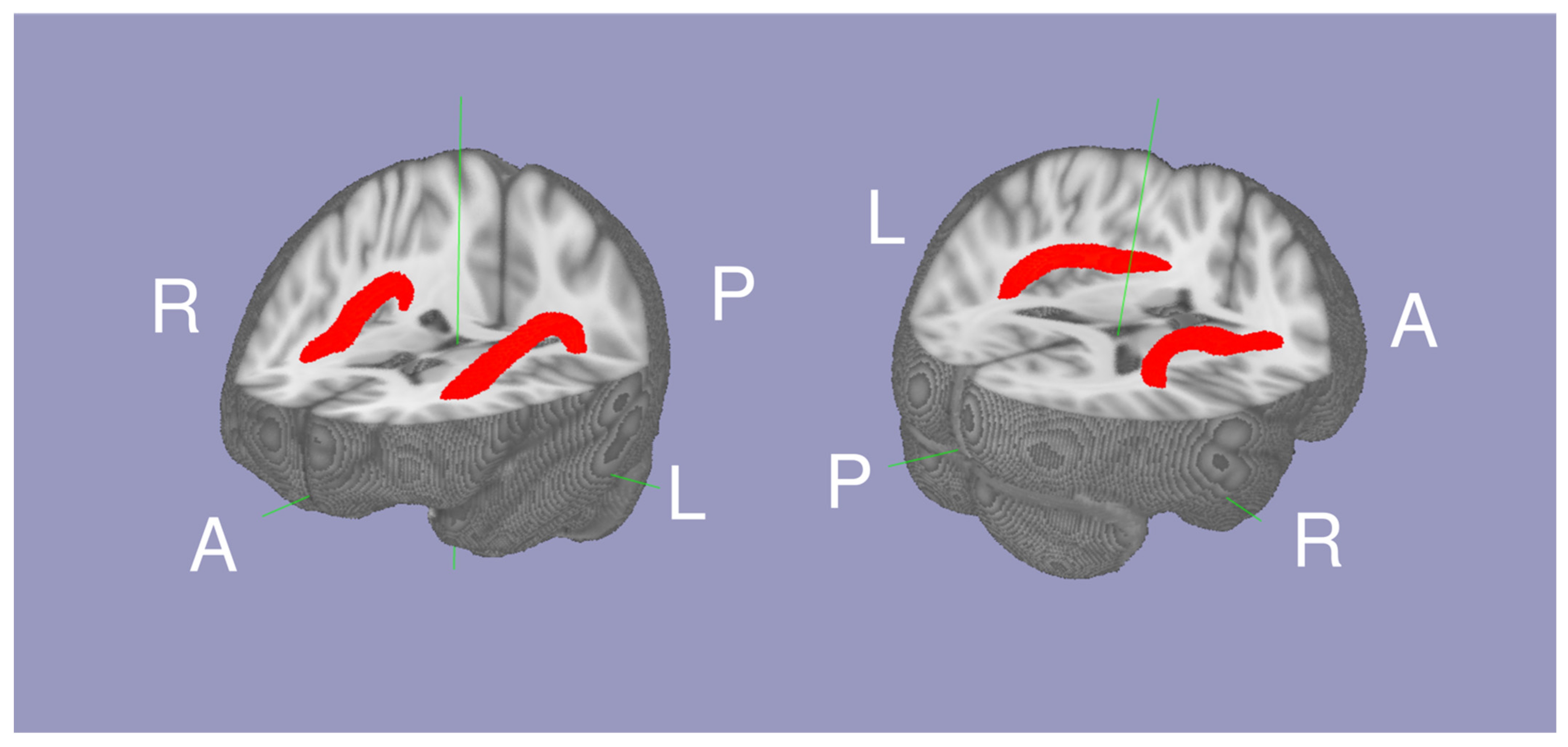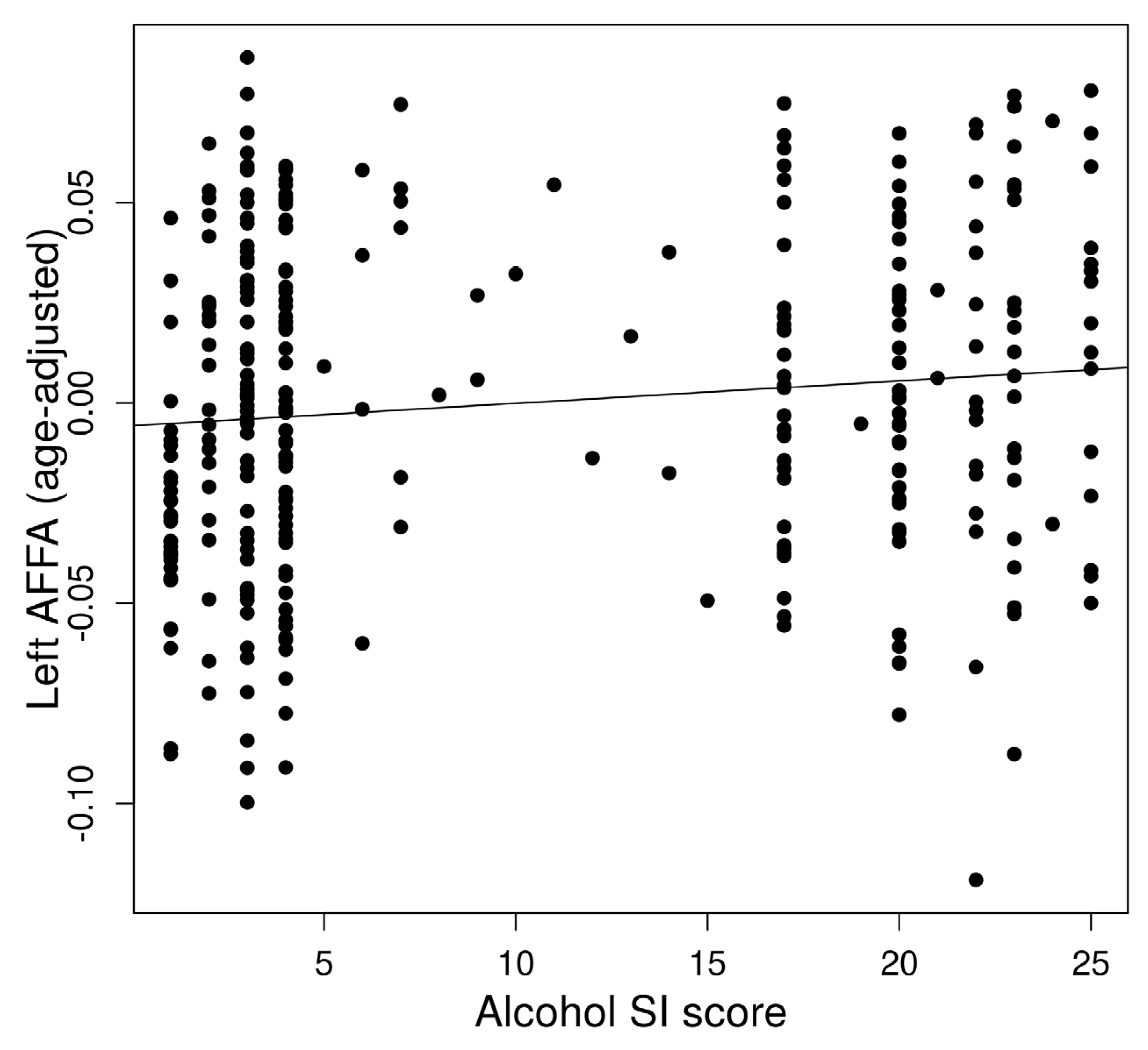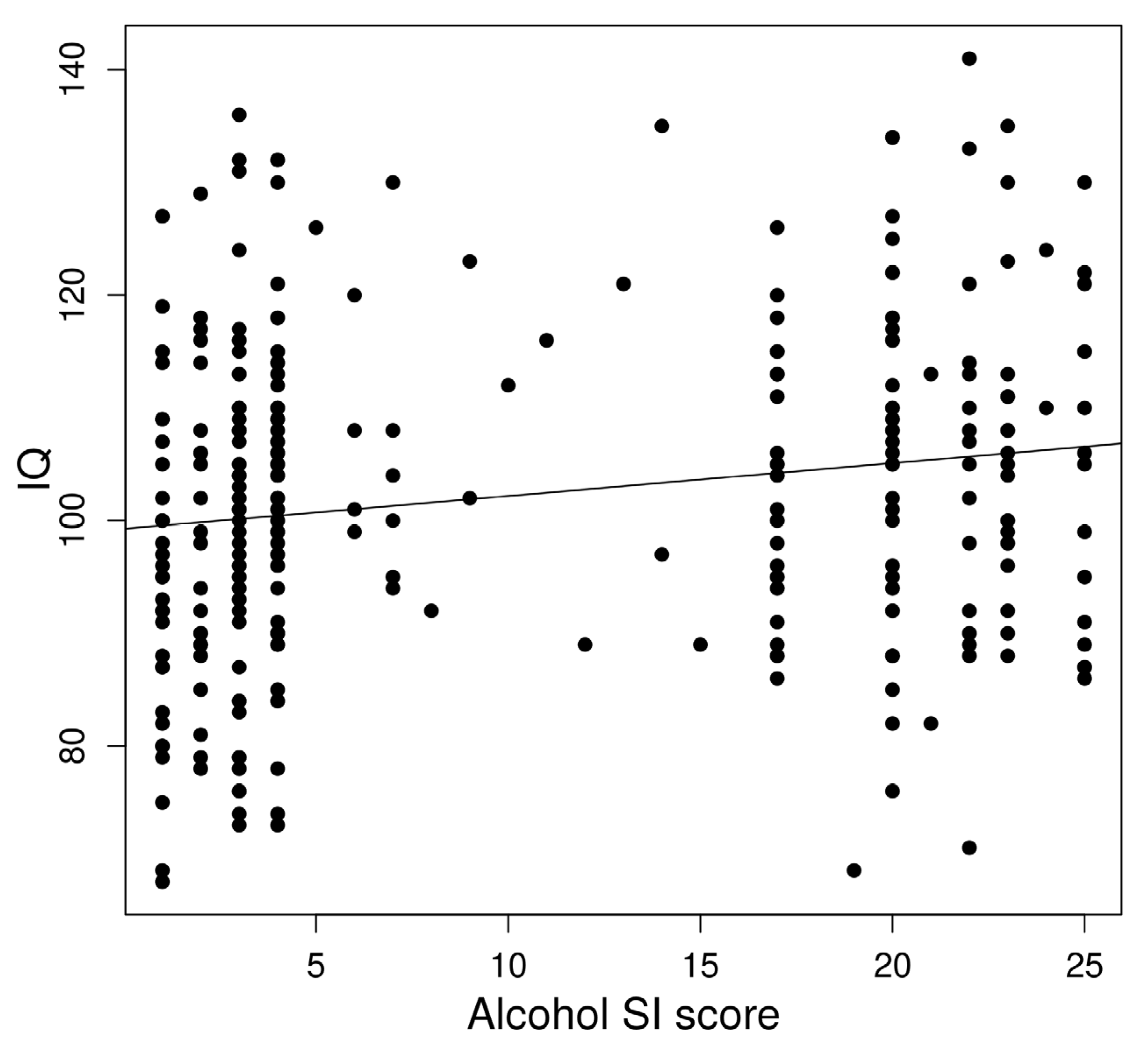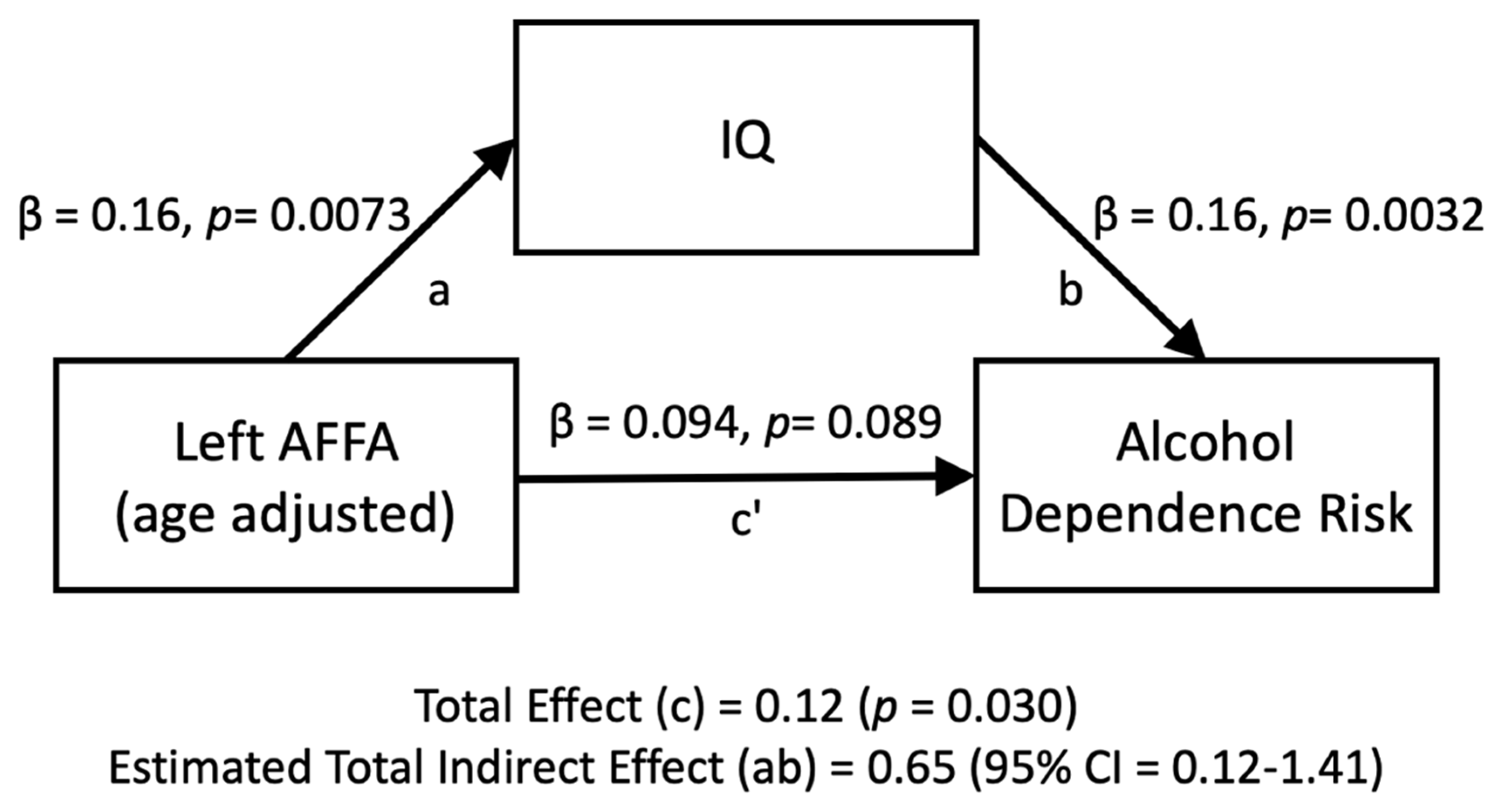Arcuate Fasciculus Microstructure Predicts Alcohol Dependence Risk through Higher IQ
Abstract
1. Introduction
2. Materials and Methods
3. Results
4. Discussion
5. Conclusions
Author Contributions
Funding
Institutional Review Board Statement
Informed Consent Statement
Data Availability Statement
Acknowledgments
Conflicts of Interest
References
- Rilling, J.K.; Glasser, M.F.; Preuss, T.M.; Ma, X.; Zhao, T.; Hu, X.; Behrens, T.E.J. The Evolution of the Arcuate Fasciculus Revealed with Comparative DTI. Nat. Neurosci. 2008, 11, 426. [Google Scholar] [CrossRef] [PubMed]
- Belasen, A.; Hafer, R.W. IQ and Alcohol Consumption: International Data. Intelligence 2013, 41, 615–621. [Google Scholar] [CrossRef]
- Sjölund, S.; Allebeck, P.; Hemmingsson, T. Intelligence Quotient (IQ) in Adolescence and Later Risk of Alcohol-Related Hospital Admissions and Deaths—37-Year Follow-up of Swedish Conscripts. Addiction 2012, 107, 89–97. [Google Scholar] [CrossRef] [PubMed]
- Mortensen, L.H.; Sørensen, T.I.A.; Grønbæk, M. Intelligence in Relation to Later Beverage Preference and Alcohol Intake. Addiction 2005, 100, 1445–1452. [Google Scholar] [CrossRef] [PubMed]
- McEvoy, L.K.; Fennema-Notestine, C.; Elman, J.A.; Eyler, L.T.; Franz, C.E.; Hagler, D.J.; Hatton, S.N.; Lyons, M.J.; Panizzon, M.S.; Dale, A.M.; et al. Alcohol Intake and Brain White Matter in Middle Aged Men: Microscopic and Macroscopic Differences. NeuroImage Clin. 2018, 18, 390–398. [Google Scholar] [CrossRef]
- Fein, G.; Sclafani, V.D.; Cardenas, V.A.; Goldmann, H.; Tolou-Shams, M.; Meyerhoff, D.J. Cortical Gray Matter Loss in Treatment-Naïve Alcohol Dependent Individuals. Alcohol. Clin. Exp. Res. 2002, 26, 558–564. [Google Scholar] [CrossRef]
- Jernigan, T.L.; Butters, N.; DiTraglia, G.; Schafer, K.; Smith, T.; Irwin, M.; Grant, I.; Schuckit, M.; Cermak, L.S. Reduced Cerebral Grey Matter Observed in Alcoholics Using Magnetic Resonance Imaging. Alcohol. Clin. Exp. Res. 1991, 15, 418–427. [Google Scholar] [CrossRef]
- Pfefferbaum, A.; Sullivan, E.V.; Rosenbloom, M.J.; Mathalon, D.H.; Lim, K.O. A Controlled Study of Cortical Gray Matter and Ventricular Changes in Alcoholic Men Over a 5-Year Interval. Arch. Gen. Psychiatry 1998, 55, 905–912. [Google Scholar] [CrossRef]
- Fukuda, K.; Yuzuriha, T.; Kinukawa, N.; Murakawa, R.; Takashima, Y.; Uchino, A.; Ibayashi, S.; Iida, M.; Yao, H.; Hirano, M. Alcohol Intake and Quantitative MRI Findings among Community Dwelling Japanese Subjects. J. Neurol. Sci. 2009, 278, 30–34. [Google Scholar] [CrossRef]
- Gazdzinski, S.; Durazzo, T.C.; Studholme, C.; Song, E.; Banys, P.; Meyerhoff, D.J. Quantitative Brain MRI in Alcohol Dependence: Preliminary Evidence for Effects of Concurrent Chronic Cigarette Smoking on Regional Brain Volumes. Alcohol. Clin. Exp. Res. 2005, 29, 1484–1495. [Google Scholar] [CrossRef]
- Pfefferbaum, A.; Lim, K.O.; Zipursky, R.B.; Mathalon, D.H.; Rosenbloom, M.J.; Lane, B.; Ha, C.N.; Sullivan, E.V. Brain Gray and White Matter Volume Loss Accelerates with Aging in Chronic Alcoholics: A Quantitative MRI Study. Alcohol. Clin. Exp. Res. 1992, 16, 1078–1089. [Google Scholar] [CrossRef] [PubMed]
- Sullivan, E.V.; Deshmukh, A.; Desmond, J.E.; Lim, K.O.; Pfefferbaum, A. Cerebellar Volume Decline in Normal Aging, Alcoholism, and Korsakoff’s Syndrome: Relation to Ataxia. Neuropsychology 2000, 14, 341–352. [Google Scholar] [CrossRef] [PubMed]
- Sullivan, E.V.; Deshmukh, A.; Rosa, E.D.; Rosenbloom, M.J.; Pfefferbaum, A. Striatal and Forebrain Nuclei Volumes: Contribution to Motor Function and Working Memory Deficits in Alcoholism. Biol. Psychiatry 2005, 57, 768–776. [Google Scholar] [CrossRef] [PubMed]
- De Santis, S.; Bach, P.; Pérez-Cervera, L.; Cosa-Linan, A.; Weil, G.; Vollstädt-Klein, S.; Hermann, D.; Kiefer, F.; Kirsch, P.; Ciccocioppo, R.; et al. Microstructural White Matter Alterations in Men with Alcohol Use Disorder and Rats with Excessive Alcohol Consumption During Early Abstinence. JAMA Psychiatry 2019, 76, 749. [Google Scholar] [CrossRef] [PubMed]
- Pfefferbaum, A.; Sullivan, E.V. Disruption of Brain White Matter Microstructure by Excessive Intracellular and Extracellular Fluid in Alcoholism: Evidence from Diffusion Tensor Imaging. Neuropsychopharmacology 2005, 30, 423–432. [Google Scholar] [CrossRef]
- Ikuta, T.; Gollnick, H.M.; Rutledge, A.N. Age Associated Decline in the Arcuate Fasciculus and IQ. Brain Imaging Behav. 2020, 14, 362–367. [Google Scholar] [CrossRef]
- Nooner, K.; Colcombe, S.; Tobe, R.; Mennes, M.; Benedict, M.; Moreno, A.; Panek, L.; Brown, S.; Zavitz, S.; Li, Q.; et al. The NKI-Rockland Sample: A Model for Accelerating the Pace of Discovery Science in Psychiatry. Front. Neurosci. 2012, 6, 152. [Google Scholar] [CrossRef]
- Desikan, R.S.; Ségonne, F.; Fischl, B.; Quinn, B.T.; Dickerson, B.C.; Blacker, D.; Buckner, R.L.; Dale, A.M.; Maguire, R.P.; Hyman, B.T.; et al. An Automated Labeling System for Subdividing the Human Cerebral Cortex on MRI Scans into Gyral Based Regions of Interest. NeuroImage 2006, 31, 968–980. [Google Scholar] [CrossRef]
- Kelley, K. MBESS: The MBESS R Package 2020. Available online: https://cran.r-project.org/web/packages/MBESS/index.html.
- Ioime, L.; Guglielmo, R.; Affini, G.F.; Quatrale, M.; Martinotti, G.; Callea, A.; Savi, E.; Janiri, L. Neuropsychological Performance in Alcohol Dependent Patients: A One-Year Longitudinal Study. Psychiatry Investig. 2018, 15, 505–513. [Google Scholar] [CrossRef]
- Fortier, C.B.; Leritz, E.C.; Salat, D.H.; Lindemer, E.; Maksimovskiy, A.L.; Shepel, J.; Williams, V.; Venne, J.R.; Milberg, W.P.; McGlinchey, R.E. Widespread Effects of Alcohol on White Matter Microstructure. Alcohol. Clin. Exp. Res. 2014, 38, 2925–2933. [Google Scholar] [CrossRef]
- Mulhauser, K.; Weinstock, J.; Ruppert, P.; Benware, J. Changes in Neuropsychological Status during the Initial Phase of Abstinence in Alcohol Use Disorder: Neurocognitive Impairment and Implications for Clinical Care. Subst. Use Misuse 2018, 53, 881–890. [Google Scholar] [CrossRef]
- Hayes, S.C.; Strosahl, K.D.; Wilson, K.G. Acceptance and Commitment Therapy, Second Edition: The Process and Practice of Mindful Change; Guilford Press: New York, NY, USA, 2011; ISBN 978-1-60918-962-4. [Google Scholar]
- Petersen, C.; Zettle, R. Treating Inpatients with Comorbid Depression and Alcohol Use Disorders: A Comparison of Acceptance and Commitment Therapy Versus Treatment as Usual. Psychol. Rec. 2010, 59, 521–536. [Google Scholar] [CrossRef]
- Lee, E.B.; An, W.; Levin, M.E.; Twohig, M.P. An Initial Meta-Analysis of Acceptance and Commitment Therapy for Treating Substance Use Disorders. Drug Alcohol Depend. 2015, 155, 1–7. [Google Scholar] [CrossRef]
- Harris, R. ACT Made Simple: An Easy-to-Read Primer on Acceptance and Commitment Therapy; New Harbinger Publications: Oakland, CA, USA, 2009; ISBN 978-1-57224-705-5. [Google Scholar]
- Grohman, K.; Fals-Stewart, W. Computer-Assisted Cognitive Rehabilitation with Substance-Abusing Patients: Effects on Treatment Response. J. Cogn. Rehabil. 2003, 21, 10–17. [Google Scholar]
- Bates, M.E.; Voelbel, G.T.; Buckman, J.F.; Labouvie, E.W.; Barry, D. Short-Term Neuropsychological Recovery in Clients with Substance Use Disorders. Alcohol. Clin. Exp. Res. 2005, 29, 367–377. [Google Scholar] [CrossRef]
- Allott, K.; Steele, P.; Boyer, F.; de Winter, A.; Bryce, S.; Alvarez-Jimenez, M.; Phillips, L. Cognitive Strengths-Based Assessment and Intervention in First-Episode Psychosis: A Complementary Approach to Addressing Functional Recovery? Clin. Psychol. Rev. 2020, 79, 101871. [Google Scholar] [CrossRef]




| N | 334 |
| Age | 42.99 ± 22.78 |
| Female:Male | 221:113 |
| IQ | 102.23 ± 14.16 |
Disclaimer/Publisher’s Note: The statements, opinions and data contained in all publications are solely those of the individual author(s) and contributor(s) and not of MDPI and/or the editor(s). MDPI and/or the editor(s) disclaim responsibility for any injury to people or property resulting from any ideas, methods, instructions or products referred to in the content. |
© 2023 by the authors. Licensee MDPI, Basel, Switzerland. This article is an open access article distributed under the terms and conditions of the Creative Commons Attribution (CC BY) license (https://creativecommons.org/licenses/by/4.0/).
Share and Cite
Ikuta, T.; Kessler, P.B.; Swoboda, A.M.; Fisher, A.K. Arcuate Fasciculus Microstructure Predicts Alcohol Dependence Risk through Higher IQ. Brain Sci. 2023, 13, 129. https://doi.org/10.3390/brainsci13010129
Ikuta T, Kessler PB, Swoboda AM, Fisher AK. Arcuate Fasciculus Microstructure Predicts Alcohol Dependence Risk through Higher IQ. Brain Sciences. 2023; 13(1):129. https://doi.org/10.3390/brainsci13010129
Chicago/Turabian StyleIkuta, Toshikazu, Paige B. Kessler, Alexandria M. Swoboda, and Amy K. Fisher. 2023. "Arcuate Fasciculus Microstructure Predicts Alcohol Dependence Risk through Higher IQ" Brain Sciences 13, no. 1: 129. https://doi.org/10.3390/brainsci13010129
APA StyleIkuta, T., Kessler, P. B., Swoboda, A. M., & Fisher, A. K. (2023). Arcuate Fasciculus Microstructure Predicts Alcohol Dependence Risk through Higher IQ. Brain Sciences, 13(1), 129. https://doi.org/10.3390/brainsci13010129







